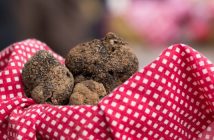Inspired by the new British Museum exhibition on Sicily’s eclectic cultural heritage, Estella Shardlow heads to the island for a front-line look at its unique cuisine and culture…
Cefalù Cathedral seems to be having an identity crisis. A supersize Christ Pantocrater looms before a wall of shimmering gold tesserae in the apse, pure Byzantine bling. Then come icing cake flourishes of Baroque marble; an austere pink granite colonnade down the nave; a façade that appears part medieval fortress, half Moorish palace. Rising up fortress-like above the terracotta rooftops of the Old Town, yet dwarfed in turn by the immense craggy ‘Rocca’ outcrop, there’s no better snapshot of Sicily’s remarkably diverse history – ruled by the Romans, Arabs, Normans and Spanish in turn.
La Rocca rather rudely interrupts our villa’s view of the cathedral – we’re perched in the hills about three miles outside Cefalù, itself an hour’s drive from the capital Palermo – but from here it’s easy to see why so many civilizations clamoured to conquer this island. A prime spot in with middle of the Med surrounded by an endless sapphire sea; green swathes almond, olive and lemon trees (not to mention a profusion of fennel spilling onto every roadside, with locals impulsively stopping their cars to cut themselves a bunch); a balmy temperature that lets you dine on the terrace in early April. This cosmopolitan identity is the subject of the British Museum’s current exhibition, Sicily: Culture and Conquest, bringing together everything from terracotta figurines of ancient Greek deities and to mosaics of the Virgin Mary, or fragments of Roman warships to 12th century ivory chess pieces.

Rather more raucous than the museum and cathedral, Cefalù’s Saturday market is another place to get a sense of the marks a myriad of cultures have left. Sicily’s cuisine has distinct differences to the Italian mainland. Sure, the passion for pasta and pastries is equally fierce, the vegetables equally sublime, but here you’ll also find the pine nuts, raisins and almonds for the quintessential Sicilian aubergine stew, caponata, and plenty of fresh seafood for its Arab-influenced couscous alla trapanese. There are balls of stretched-curd sheep cheese Caciocavallo dangle on red strings from the stalls, and tubs creamy ricotta to pipe into small, crisp pastry shells to create the ubqiuitous cannoli. My sister, food blogger Tara Smith (Taras’ Busy Kitchen), and I leave with bulging bags of artichokes, tomatoes, blood oranges and fennel, ready to cook up a storm at our home for the weekend, Villa Borghetto.
This is one of the handpicked luxury properties offered by Massimo Villas, run by born-and-bred Cefalù entrepreneur Massimo Provenza. It’s perfectly set up to make the most of the Sicilian weather, with a vast sea-facing terrace and long canopied dining table, wood firing oven, barbecue and swimming pool. Not so frequently in use these days, but equally picturesque, are the traditional wine press and stone laundry tub. A main villa and two converted barns decked out in patterned tiles and antique furniture, the property can accommodate 13 guests; it felt positively palatial for the two of us.

Massimo may be one of the most well connected men in Sicily: over three days a stream of local experts is brought out after we mentioned we’d like a little help exploring the area. Giuseppe, a doctor and owner of Madonie Holidays (having at least two jobs seemed to be quite common; I felt decidedly workshy being ‘just a journalist’), brought us to the stunning medieval hilltop town Castelbuono, where we sampled Sicily’s best Panettone from Fiasconaro – consumed by Obama and the Pope, no less – and behind the scenes at a soon-to-open national Planetarium in Isnello. We find ourselves having a quick espresso with the town mayor, before a quick look round the lace museum.
Then there was Angelo, who took us on a history-filed tour of Cefalù Old Town and harbour, before lunch at Cortile Pepe. At a table in the restaurant’s peaceful courtyard, we sampled Sicilian specialties with a contemporary twist: slow-cooked octopus was finished on the barbecue and served with a beetroot purée, crescent-shaped pasta stuffed with shrimp, a deconstructed cassata of sponge, ricotta and candied fruit, and local dessert wine Pantelleria. If you have any space left, L’Angelo Delle Dolcezze Pasticceria Geleteria serves the best gelato in town.

As we sipped Aperol Spritzes in the cathedral’s palm-fringed piazza that evening, I wondered aloud about warm, welcoming and, well, matey everyone is here; in fact, every time I looked up from my glass a new face is swinging by the table for a ‘come stai?’ and catch-up. Everyone knows, and wants to help, each other – like the best bits of the Mafia without the horses’ heads and dirty money. According to Angelo, it’s down to Sicily’s heritage; the constant stream of settlers and occupiers, which means it’s always been open to outsiders.
Our final day concludes with a sailing trip, nibbling on arancini (risotto balls) and sfincione (a sort of pizza with a thick doughy base) as the boat drifts along Sicily’s craggy northern shore. ‘Release the dolphins, Massimo!’ I declare, joking about how this day has been just one notch away from perfection. Ten minutes later, a bottlenose breaks the surface of the waves.
Estella was a guest of Massimo Villas, offering hand-picked luxury villas across Sicily. For more information, visit www.massimovillas.com. Other holiday rentals and excursions in Cefalù can be found with www.madonieholidays.it. For more on Sicilian cuisine, visit www.tarasbusykitchen.com.
‘Sicily: Culture and Conquest’ is at the British Museum until 14 August 2016. For more information, visit www.britishmuseum.org.




